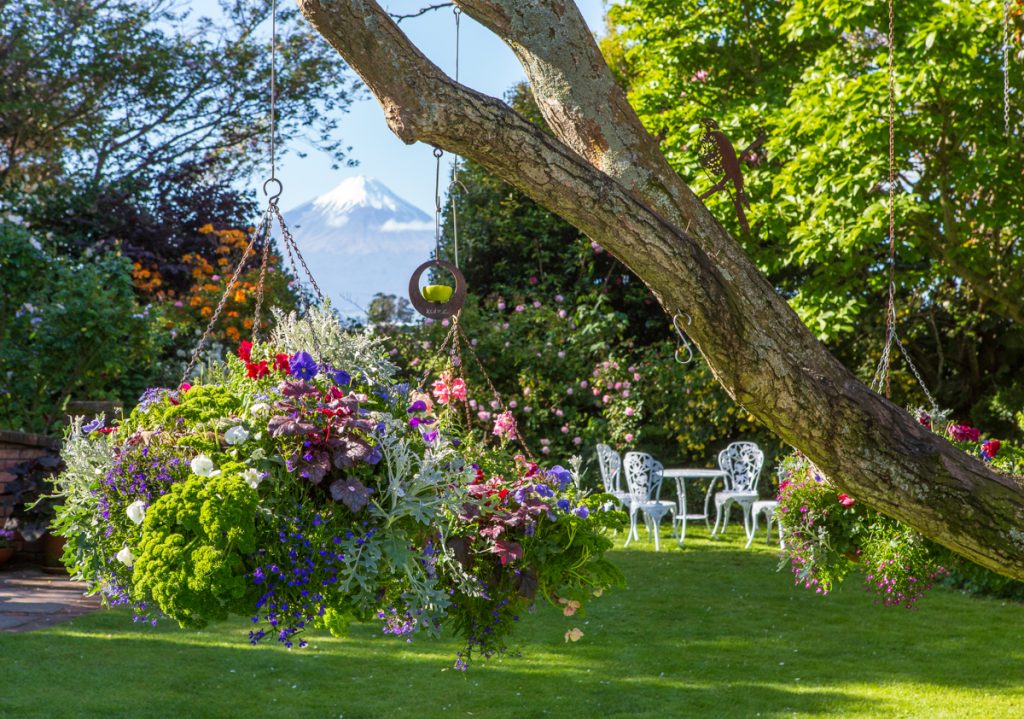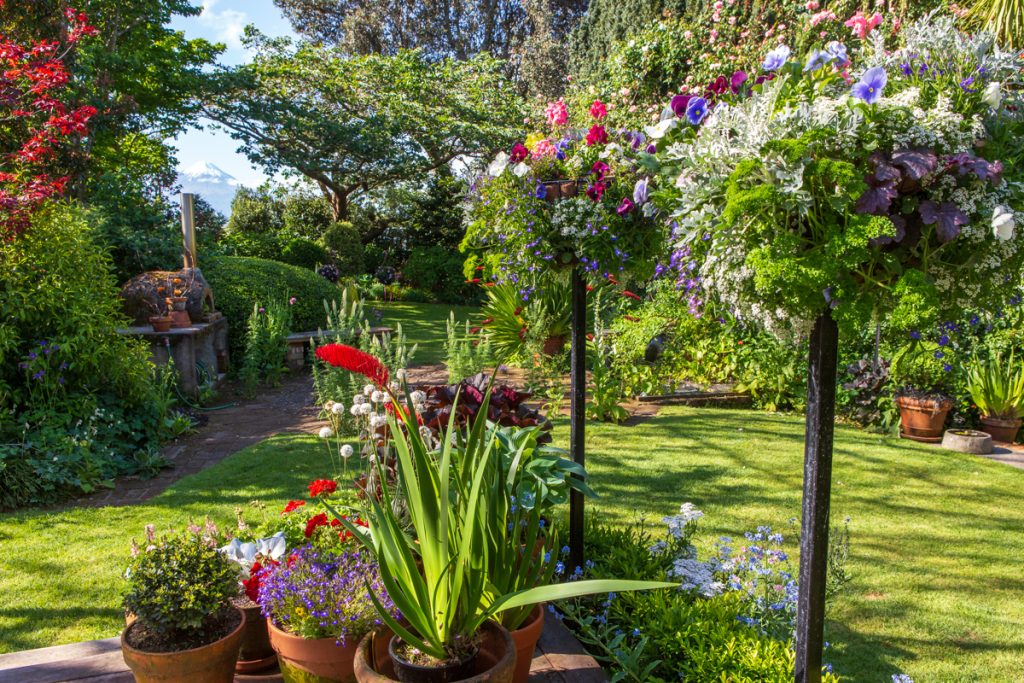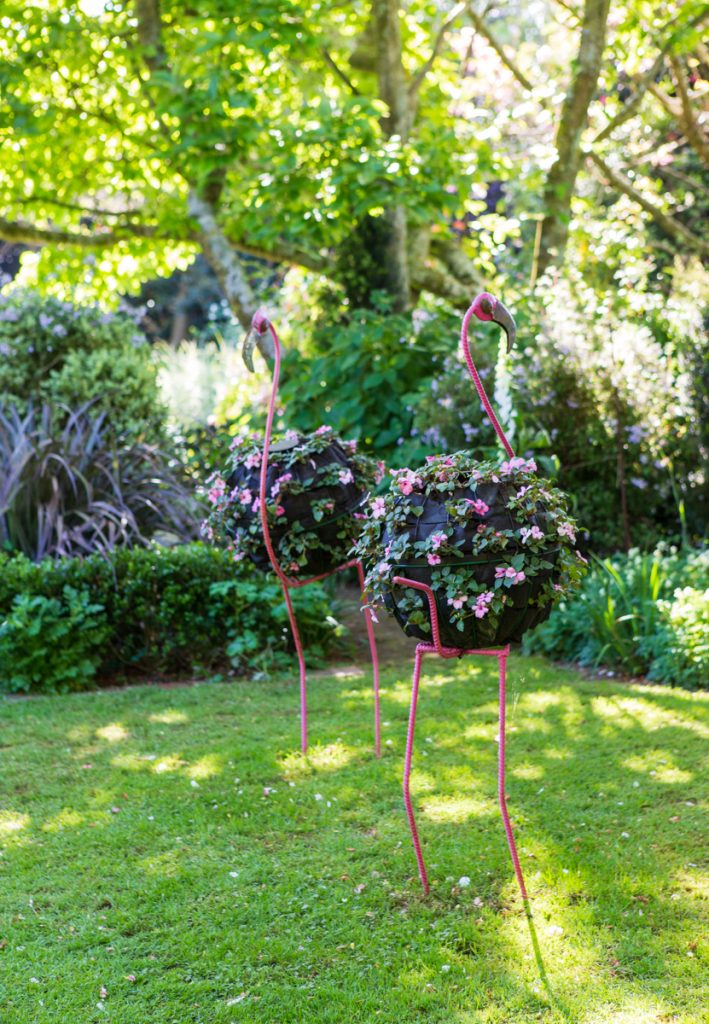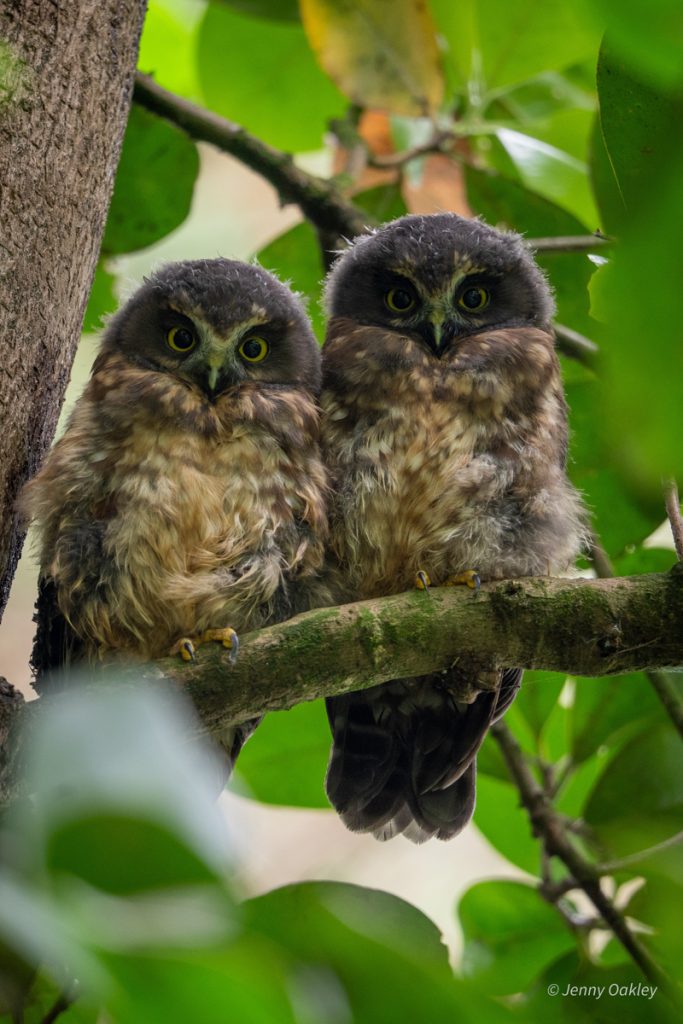A National Star
Jenny and Guy Oakley have been welcoming visitors to their stunning garden for decades, and this year will mark the 38th time they have taken part in the Centuria Taranaki Garden Festival. With spectacular mountain views, lush borders and a chorus of native birds, it’s not surprising that Oakley Garden was named a Garden of International Significance.
Words Virginia Winder Photos Jane Dove Juneau

Strong gusts sideswipe cars coasting along Surf Highway 45, but inside Jenny and Guy Oakley’s Manaia garden there’s barely a breeze. ‘The first thing we did was plant shelter – nothing grows without any shelter down here,’ says Jenny of the windswept South Taranaki coastline. Sitting outside, just out of reach of an old walnut tree laden with its autumn bounty, the deck is calm, warm and drenched in sunshine.
Jenny, the horticulturist, and Guy, the vet, have lived here since 1984, the year after they married.
They bought four hectares and an old house, and began protecting the property by planting karo, willows, poplars, pseudopanax hybrids, coast honeysuckle trees (Banksia integrifolia) and pōhutukawa.
More than 40 years on, Oakley Garden is embraced by a fortification of foliage and is a national star.
In 2023, it was named a Garden of International Significance by the New Zealand Gardens Trust. It’s also a stayer, being the only property to open for every Centuria Taranaki Garden Festival since it began in 1987. This year, from 31 October to 9 November, marks the 38th time Jenny, Guy and their helpers, friends and whānau will welcome visitors.
Chief greeter is Jenny’s dad, David Lloyd, now in his nineties. ‘I’m sure they come to see him, not me,’ Jenny laughs. He usually sits near the walnut tree, which in spring holds hanging baskets.
During the festival she runs demonstrations showing people how to create their own and shares propagation tips. Jenny, also a garden assessor, has a degree in amenity horticulture but says she learnt as much during three years at Hollard Gardens in Kaponga.

There are two parts to Oakley Garden – its public face and behind the scenes. Out of sight are a lake and orchard, and Jenny’s nursery, shade houses, a tunnel house, veggie gardens, berry houses bursting with blueberries, and a big raspberry patch. ‘We’ve got so many raspberries, the kids think I’m ridiculous because I can pick up to 7 kg a day,’ says Jenny. ‘I’m so tired after I’ve picked them all, I can’t face thinking about selling them, so I just give them to people who have been helping me all year. We do this big delivery thing all December.’
Visitors see a haven with a mountain view, garden rooms formed by shrubs, plump borders, lofty trees and clipped buxus, all joined by lawns, paved islands and steps. The Oakley Garden is soft and curvaceous, with hydrangeas, hostas, old-fashioned roses like the climbing Souvenir de Madame Leonie Viennot by the tennis court, and flowers including honesty, aquilegias and poppies. Rhododendrons, camellias, clematis, Japanese maples and flowering cherries add beauty, particularly a lichen-limbed Prunus ‘Shimidsu Sakura’ below the steps.
Pots around the property are flush with scarlet plumes of Xeronema callistemon, or Poor Knights lily (raupōtaranga). ‘They used to be quite rare plants, and rare to be found in flower, but now they are more commonly used in street plantings, and lots of people have them,’ says Jenny. ‘One of the real perks about growing plants to sell is when people come back – we have a lot of people who revisit – and say, oh, my xeronema’s flowering.’ Hers are loved by visitors, especially tauhou (silvereye or waxeye), who end up red-faced from feasting on the long bottle-brush flowers each spring.
During the festival, a pop-up garden centre appears on the tennis court. Jenny grew flowers, which she cut, dried and sold to fund the court. Her hanging baskets, some on stands and adorning a new deck, are flourishing features, but some have grown feathers – with help from Guy. ‘I said her baskets were getting boring,’ he jokes. So, he welded bird-shaped frames to create a whānau of six moa, and two flamingos. The extinct native birds are planted with mondo grass – black for the juveniles and green for the adults. Shocking-pink impatiens form the plumage of the wading birds, which their grandson Arthur calls the ‘mingos’.

Guy, who retired in 2018 after 40 years as the local vet, is Jenny’s right-hand man. He maintains paths, carts rubbish, builds structures, nurtures the moa and flamingos, and cooks when Jenny is working late or photographing birds – a major passion. Last year, she needed extra support after suffering a head injury. ‘For about eight weeks the horizon moved all the time. And I couldn’t bend over because I couldn’t trust myself to stand back up again,’ she says. ‘For a long time I couldn’t do anything. But I think gardening was the best rehab exercise because I could choose what I could do.’
During festival time, she had a short rest during the day, leaving her team to take the reins. She still struggles with concentration and sensory over-stimulation. Outside, in her healing haven, she no longer turns on RNZ National all day but tunes into the birds. Always, she wears a gifted khaki gardening apron, its pockets packed with labels, pencil, string and tools, tied with pink tracking tape to avoid being lost. She favours Niwashi tools for digging and weeding and always has secateurs ready. ‘I always say next time I’m going to get born with secateurs on one hand,’ she says.
‘Jenny Scissorhands,’ quips Guy.
Jenny comes from a long line of green-fingered folk and says their adult sons, Glen, Craig and Alex, are all reasonably good gardeners, although they had to be paid to help when growing up. For Jenny, it’s important the garden is looked after.
‘I feel quite discombobulated if the garden gets unkempt or if I haven’t been in the garden, that’s what happens. It’s just like people that need to go and paint or run or climb mountains,’ she says. ‘I need to garden.’

Birds Up Close
Birds are a strong theme in the life of Jenny and Guy Oakley these days – both at home and beyond.
‘We work with the Taranaki Kiwi Trust,’ says Jenny. They volunteer at Rotokare Scenic Reserve, the region’s only pest-free sanctuary, where they help with the annual translocation of 30 to 50 kiwi to safe areas around Taranaki. Guy, with his veterinary experience, assists with health checks and treatments. The couple would love to have the iconic birds in their garden. ‘If Predator Free 2050 works, maybe one day they’ll be here,’ Guy says.
But the garden does host a chorus of native birds, including ruru (moreporks), pīwakawaka (fantails), riroriro (grey warblers), korimako (bellbirds) and once, even a kārearea (hawk) dropped in.
It was the ruru that sparked Jenny’s passion for bird photography. ‘Probably 10 years ago we stumbled across the morepork in the garden. They don’t call very much here so it was a surprise to see it.’
After a few years, they realised there were two in the garden. To help identify them, Jenny zoomed in closer with a camera lens, and so her photography interest began. ‘I spent all this time photographing moreporks and about that time we started working out at Rotokare and it just kind of morphed into other birds.’
To help her bird-watching, Jenny upgraded her camera equipment. These days she wields a Sony A7IV with a 150–500 mm lens. ‘It’s such a privilege to see them up close.’
At the 2024 Centuria Taranaki Garden Festival, she had some of her bird photos for sale and will again this year.
The Centuria Taranaki Garden Festival will be held 31 October – 9 November 2025.

